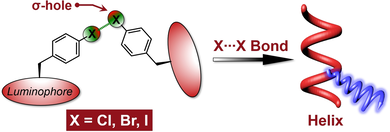X⋅⋅⋅X Halogen Bond-Induced Supramolecular Helices
Graphical Abstract
X⋅⋅⋅X (X=Cl, Br, I) type weak halogen bonds induce the formation of supramolecular helical structures both in solid and solution state. The halogen bonds could further influence the helical nanoarchitectures in mono- and multiple-component coassemblies with melamine, providing a flexible route to prepare chiral functional materials.
Abstract
The halogen bond is the attractive interaction between the electrophilic region of a halogen atom and the nucleophilic region of another molecular entity, emerging as a favorable manner to manipulate supramolecular chirality in self-assemblies. Engineering halogen bonded helical structures remains a challenge due to its sensitivity to solvent polarity and competitive forces like hydrogen bonds. Herein, we report a X⋅⋅⋅X (X=Cl, Br, I) type weak halogen bond that induces the formation and evolution of supramolecular helical structures both in solid and solution state. The π-conjugated phenylalanine derivatives with F, Cl, Br and I substitution self-assembled into 21 helical packing driven by hydrogen bond and halogen bond, respectively. The specific molecular geometries of π-conjugated amino acids gave rise to multiple noncovalent forces to stabilize the X⋅⋅⋅X halogen bond with small bond energies ranging from −0.69 to −1.49 kcal mol−1. Halogen bond induced an opposite helicity compared to the fluorinated species, accompanied by the inversed circularly polarized luminescence.
Conflict of interest
The authors declare no conflict of interest.





